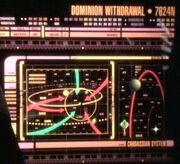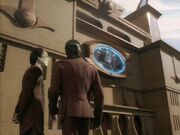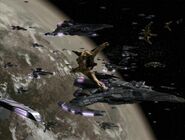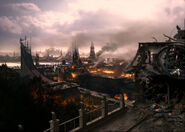m (Robot: Automated text replacement (-''\{\{w\|(.+?)}}'' +{{wt|\1}})) Tag: apiedit |
m (Robot: Automated text replacement (-. +. )) Tag: apiedit |
||
| (8 intermediate revisions by 4 users not shown) | |||
| Line 16: | Line 16: | ||
In [[2375]], the location of Cardassia was labeled on a tactical map that was displayed in the wardroom of [[Deep Space 9]]. Cardassia was located approximately five [[light year]]s from [[Bajor]], thirty light years from [[Starbase 375]], and fifty-five light years from [[Ferenginar]]. ({{DS9|When It Rains...}}, ''[[okudagram]]'') |
In [[2375]], the location of Cardassia was labeled on a tactical map that was displayed in the wardroom of [[Deep Space 9]]. Cardassia was located approximately five [[light year]]s from [[Bajor]], thirty light years from [[Starbase 375]], and fifty-five light years from [[Ferenginar]]. ({{DS9|When It Rains...}}, ''[[okudagram]]'') |
||
| − | {{bginfo|According to ''[[Star Trek: Deep Space Nine Technical Manual]]'', ( |
+ | {{bginfo|According to ''[[Star Trek: Deep Space Nine Technical Manual]]'', (p. 3) the exact distance between Cardassia and Bajor was 5.25 light years. According to a [[stellar cartography]] map on the same page, Cardassia was located in the [[Bajor sector]]. [http://www.stdimension.org/Cartography/Maps.htm#OfficialMaps]}} |
Later that year, the position and [[orbit]]al path of Cardassia was illustrated on a tactical map that was displayed in the wardroom of Deep Space 9. ({{DS9|The Dogs of War}}, ''okudagram'') |
Later that year, the position and [[orbit]]al path of Cardassia was illustrated on a tactical map that was displayed in the wardroom of Deep Space 9. ({{DS9|The Dogs of War}}, ''okudagram'') |
||
| Line 34: | Line 34: | ||
'''Locations''' |
'''Locations''' |
||
* [[Imperial Plaza]] |
* [[Imperial Plaza]] |
||
| + | * [[University of Culat]] |
||
=== Flora and fauna === |
=== Flora and fauna === |
||
| Line 48: | Line 49: | ||
Prior to the militarization of the Cardassian government, Cardassia was home to some of the finest art and architecture in the quadrant. However, the once great Cardassian [[First Hebitian civilization|civilization]] fell in to severe decay. Due to the planet's scarcity in natural resources, the impoverished society suffered from famine and disease, leading to millions of deaths. The [[Cardassian military]] continued this destruction of its heritage in order to fund the [[Federation-Cardassian War]]. ({{TNG|Chain of Command, Part II}}) |
Prior to the militarization of the Cardassian government, Cardassia was home to some of the finest art and architecture in the quadrant. However, the once great Cardassian [[First Hebitian civilization|civilization]] fell in to severe decay. Due to the planet's scarcity in natural resources, the impoverished society suffered from famine and disease, leading to millions of deaths. The [[Cardassian military]] continued this destruction of its heritage in order to fund the [[Federation-Cardassian War]]. ({{TNG|Chain of Command, Part II}}) |
||
| − | At the end of the [[Dominion War]], determined to punish the Cardassian people for their acts of [[Cardassian Rebellion|rebellion]] against the [[Dominion]], [[Weyoun]] ordered that [[Lakarian City]] be destroyed, resulting in the deaths of two million civilians. This could not, however, have prepared the Cardassian people for an even greater tragedy. After the destruction of Lakarian City, the Cardassian forces switched sides to aid the [[Federation Alliance]]. Enraged by the turn of events and betrayal, the [[Female Changeling]] demanded that the Cardassian people be wiped out. After planetary bombardment from the Dominion and [[Breen]] fleets in orbit and mass slaughter from the [[Jem'Hadar]] on the planet surface, the death toll stood at an estimated eight hundred million Cardassians, with a large portion of the cities in ruins. |
+ | At the end of the [[Dominion War]], determined to punish the Cardassian people for their acts of [[Cardassian Rebellion|rebellion]] against the [[Dominion]], [[Weyoun]] ordered that [[Lakarian City]] be destroyed, resulting in the deaths of two million civilians. This could not, however, have prepared the Cardassian people for an even greater tragedy. After the destruction of Lakarian City, the Cardassian forces switched sides to aid the [[Federation Alliance]]. Enraged by the turn of events and betrayal, the [[Female Changeling]] demanded that the Cardassian people be wiped out. After planetary bombardment from the Dominion and [[Breen]] fleets in orbit and mass slaughter from the [[Jem'Hadar]] on the planet surface, the death toll stood at an estimated eight hundred million Cardassians, with a large portion of the cities in ruins. ({{DS9|What You Leave Behind}}) |
<gallery> |
<gallery> |
||
File:Dominion fleet regroups at Cardassia Prime.jpg|Dominion and Breen ships and [[orbital weapon platform]]s in orbit of Cardassia Prime |
File:Dominion fleet regroups at Cardassia Prime.jpg|Dominion and Breen ships and [[orbital weapon platform]]s in orbit of Cardassia Prime |
||
| Line 81: | Line 82: | ||
=== Background information=== |
=== Background information=== |
||
[[File:Cardassian Court TV.jpg|thumb|A Cardassian trial is broadcast in the streets on Cardassia]] |
[[File:Cardassian Court TV.jpg|thumb|A Cardassian trial is broadcast in the streets on Cardassia]] |
||
| − | "car-DASS-ee-uh" was the pronunciation for this planet's name from the script pronunciation guide for "Tribunal". {{ |
+ | "car-DASS-ee-uh" was the pronunciation for this planet's name from the script pronunciation guide for "Tribunal". {{st-minutiae|resources/scripts/445.txt}} |
The DS9 writing staff hoped to establish Cardassia in the [[DS9 Season 2|second season]] of the series. "''We're going to have to explore what Cardassia is,''" declared [[Ira Steven Behr]]. (''[[Cinefantastique]]'', Vol. 24, Nos. 3/4, p. 108) |
The DS9 writing staff hoped to establish Cardassia in the [[DS9 Season 2|second season]] of the series. "''We're going to have to explore what Cardassia is,''" declared [[Ira Steven Behr]]. (''[[Cinefantastique]]'', Vol. 24, Nos. 3/4, p. 108) |
||
| Line 95: | Line 96: | ||
Following its on-screen debut in "Tribunal", plans were made for Cardassia to continue being developed in [[DS9 Season 3]]. "''There are things happening on Cardassia which you heard a bit about in 'The Maquis' and 'The Wire'. We're going to keep that bubbling,''" stated Ira Steven Behr. (''[[Cinefantastique]]'', Vol. 25/26, No. 6/1, p. 98) At the conclusion of that season, Behr declared that "deepening Cardassia" was an important goal for the writers to bear in mind for [[DS9 Season 4|the fourth season]]. (''[[Cinefantastique]]'', Vol. 27, No. 4/5, p. 115) |
Following its on-screen debut in "Tribunal", plans were made for Cardassia to continue being developed in [[DS9 Season 3]]. "''There are things happening on Cardassia which you heard a bit about in 'The Maquis' and 'The Wire'. We're going to keep that bubbling,''" stated Ira Steven Behr. (''[[Cinefantastique]]'', Vol. 25/26, No. 6/1, p. 98) At the conclusion of that season, Behr declared that "deepening Cardassia" was an important goal for the writers to bear in mind for [[DS9 Season 4|the fourth season]]. (''[[Cinefantastique]]'', Vol. 27, No. 4/5, p. 115) |
||
| − | The DS9 writing staff continued elaborating on the politics of Cardassia. In season four offering {{e|Indiscretion}}, the writers used the planet to metaphorically represent the USSR during the period after the Berlin Wall came down, when communism waned in favor of capitalism. "''We were kind of going down that road with Cardassia,''" reflected [[Robert Hewitt Wolfe]]. (''[[Star Trek: Deep Space Nine Companion]]'', p. 274) Similarly, Wolfe likened Cardassia, shortly before it joined the Dominion in [[DS9 Season 5|fifth season]] installment {{e|By Inferno's Light}}, to impoverished Germany under the governance of the {{w| |
+ | The DS9 writing staff continued elaborating on the politics of Cardassia. In season four offering {{e|Indiscretion}}, the writers used the planet to metaphorically represent the USSR during the period after the Berlin Wall came down, when communism waned in favor of capitalism. "''We were kind of going down that road with Cardassia,''" reflected [[Robert Hewitt Wolfe]]. (''[[Star Trek: Deep Space Nine Companion]]'', p. 274) Similarly, Wolfe likened Cardassia, shortly before it joined the Dominion in [[DS9 Season 5|fifth season]] installment {{e|By Inferno's Light}}, to impoverished Germany under the governance of the {{w|Weimar Republic}} in the time between the two world wars. "''Cardassia was losing,''" he noted. (''[[Star Trek: Deep Space Nine Companion]]'', p. 427) |
At one time, writing duo [[David Weddle]] and [[Bradley Thompson]] – taking inspiration from a news story about Russian scientists who were extracting plutonium from nuclear warheads and selling it, and bearing in mind Cardassia Prime was falling apart – imagined what would happen if the planet's inhabitants decided to sell off Cardassia's weapons. This idea was the genesis of season five outing {{e|Business as Usual}}, though the planet was ultimately written out of the story. (''[[Star Trek: Deep Space Nine Companion]]'', pp. 437-438) |
At one time, writing duo [[David Weddle]] and [[Bradley Thompson]] – taking inspiration from a news story about Russian scientists who were extracting plutonium from nuclear warheads and selling it, and bearing in mind Cardassia Prime was falling apart – imagined what would happen if the planet's inhabitants decided to sell off Cardassia's weapons. This idea was the genesis of season five outing {{e|Business as Usual}}, though the planet was ultimately written out of the story. (''[[Star Trek: Deep Space Nine Companion]]'', pp. 437-438) |
||
| Line 105: | Line 106: | ||
Views of Cardassia from orbit were included in visual effects footage from {{e|What You Leave Behind}} which was supervised by [[David Stipes]]. (''[[Cinefantastique]]'', Vol. 32, Nos. 4/5, pp. 87 & 88) |
Views of Cardassia from orbit were included in visual effects footage from {{e|What You Leave Behind}} which was supervised by [[David Stipes]]. (''[[Cinefantastique]]'', Vol. 32, Nos. 4/5, pp. 87 & 88) |
||
| − | According to ''[[Star Trek: Star Charts]]'' (pp. 35, 43 & 46) |
+ | According to ''[[Star Trek: Star Charts]]'' (pp. 35, 43 & 46) and the ''[[Stellar Cartography: The Starfleet Reference Library]]'' ("The Dominion War: Strategy and Battles, 2373-75" & "Stellar Cartography", p. 18, 20-21), the capital of Cardassia (Cardassia VI) was [[Lakat]]. The dominant species were the [[humanoid]] Cardassians. In [[2378]], the population was 7.9 billion. The Cardassians have been warp-capable since [[1925]]. Major attractions of the planet included the [[Imperial Plaza]], the [[Lakarian City|Lakarian]] Amusement Park, and [[University of Culat]]. In [[December]] 2375, the Battle of Cardassia was won by the Federation and its allies. During this battle, the Dominion instrumented a planet-wide "vengeance genocide" against their former allies. Most of the major cities were destroyed. Lakat alone suffered 2 million dead. Most After the war, Bajorans aided the Cardassians in the rebuilding of their world. |
=== Apocrypha === |
=== Apocrypha === |
||
In the non-canon novel ''[[A Stitch in Time]]'', [[Elim Garak]] aids in the reconstruction of Cardassia after the Dominion War. Furthermore, despite opposition from prominent figures such as [[Gul]] [[Evek]] and Gul [[Madred]], Cardassia took on a democratic-styled government, ending the military's rule. |
In the non-canon novel ''[[A Stitch in Time]]'', [[Elim Garak]] aids in the reconstruction of Cardassia after the Dominion War. Furthermore, despite opposition from prominent figures such as [[Gul]] [[Evek]] and Gul [[Madred]], Cardassia took on a democratic-styled government, ending the military's rule. |
||
| − | In the alternate future seen in the ''Deep Space Nine'' book trilogy ''[[Millennium]]'', Cardassia Prime, along with the entire Cardassian Union, were razed by the Grigari. |
+ | In the alternate future seen in the ''Deep Space Nine'' book trilogy ''[[Millennium]]'', Cardassia Prime, along with the entire Cardassian Union, were razed by the Grigari. By the year 2399, the Cardassians were all but extinct. |
===External links=== |
===External links=== |
||
| Line 127: | Line 128: | ||
[[Category:Planets|Cardassia]] |
[[Category:Planets|Cardassia]] |
||
[[Category:Cardassia|Cardassia]] |
[[Category:Cardassia|Cardassia]] |
||
| + | [[Category:Homeworlds]] |
||
Revision as of 00:43, 4 April 2016
Cardassia Prime (or simply Cardassia) was the inhabited second and prime planet in the Cardassian system, located in the Alpha Quadrant. The planet had one moon. Cardassia Prime was the capital world of the Cardassian Union and the homeworld of the Cardassians, a warp-capable humanoid species. For two years, from 2373-2375, Cardassia Prime was an ally of the Dominion.
Location

The location of Cardassia in the Cardassian system
In 2375, the location of Cardassia was labeled on a tactical map that was displayed in the wardroom of Deep Space 9. Cardassia was located approximately five light years from Bajor, thirty light years from Starbase 375, and fifty-five light years from Ferenginar. (DS9: "When It Rains...", okudagram)
Later that year, the position and orbital path of Cardassia was illustrated on a tactical map that was displayed in the wardroom of Deep Space 9. (DS9: "The Dogs of War", okudagram)
Planetary features
In comparison to Humans, Cardassians preferred a darker, warmer and more humid environment, most likely reflecting the surface conditions on their homeworld. (DS9: "For the Cause")
Although Cardassia Prime was a world with few natural resources, the rare mineral jevonite could be found on the planet. (TNG: "Chain of Command, Part II")
Geographical
Cities
- Lakarian City
- Lakat
- Culat
Locations
Flora and fauna
History
- Main article: Cardassian history
Prior to the militarization of the Cardassian government, Cardassia was home to some of the finest art and architecture in the quadrant. However, the once great Cardassian civilization fell in to severe decay. Due to the planet's scarcity in natural resources, the impoverished society suffered from famine and disease, leading to millions of deaths. The Cardassian military continued this destruction of its heritage in order to fund the Federation-Cardassian War. (TNG: "Chain of Command, Part II")
At the end of the Dominion War, determined to punish the Cardassian people for their acts of rebellion against the Dominion, Weyoun ordered that Lakarian City be destroyed, resulting in the deaths of two million civilians. This could not, however, have prepared the Cardassian people for an even greater tragedy. After the destruction of Lakarian City, the Cardassian forces switched sides to aid the Federation Alliance. Enraged by the turn of events and betrayal, the Female Changeling demanded that the Cardassian people be wiped out. After planetary bombardment from the Dominion and Breen fleets in orbit and mass slaughter from the Jem'Hadar on the planet surface, the death toll stood at an estimated eight hundred million Cardassians, with a large portion of the cities in ruins. (DS9: "What You Leave Behind")
Appendices
Appearances
- TNG:
- "Chain of Command, Part I"
- "Chain of Command, Part II"
- DS9:
- "Tribunal"
- "Second Skin"
- "Defiant"
- "Trials and Tribble-ations"
- "By Inferno's Light"
- "Tears of the Prophets"
- "Image in the Sand"
- "Shadows and Symbols"
- "Treachery, Faith and the Great River"
- "Penumbra"
- "'Til Death Do Us Part"
- "Strange Bedfellows"
- "The Changing Face of Evil"
- "Tacking Into the Wind"
- "The Dogs of War"
- "What You Leave Behind"
Background information

A Cardassian trial is broadcast in the streets on Cardassia
"car-DASS-ee-uh" was the pronunciation for this planet's name from the script pronunciation guide for "Tribunal". [2]
The DS9 writing staff hoped to establish Cardassia in the second season of the series. "We're going to have to explore what Cardassia is," declared Ira Steven Behr. (Cinefantastique, Vol. 24, Nos. 3/4, p. 108)
The second season outing "The Wire" established that the Cardassian homeworld was called Cardassia Prime. The planet was first seen on screen shortly thereafter, in DS9: "Tribunal" (Season 2's penultimate episode). Benjamin Sisko actor Avery Brooks, who directed "Tribunal", had to account for the newness of the locale. "So there were new things for me to consider," he recalled, "like what the temperature was likely to be, and that kind of thing." (Star Trek: Deep Space Nine Companion, p. 150)
In "Tribunal", the Cardassian homeworld was realized with several matte paintings illustrated by Illusion Arts, Inc.. (Cinefantastique, Vol. 25/26, No. 6/1, p. 111) One such painting was specifically done by Syd Dutton and Robert Stromberg. (Star Trek: Deep Space Nine Companion, p. 150) Stromberg was instrumental in creating the views of Cardassia in "Tribunal". A matte painting he created of the episode's Cardassian cityscape took cues from space station Deep Space 9. "Robert took architectural elements from that and painted buildings that emulate that type of structure," stated David Williams, the optical cameraman at Illusion Arts. "He used dark lighting because Cardassians don't like light." Stromberg also added a volcano, in some preliminary sketches, but it was later removed, because the producers thought it was slightly too much activity for the scene. The final version of the matte painting measured 20x24 inches. (Cinefantastique, Vol. 25/26, No. 6/1, p. 72)
For the views of Cardassia in "Tribunal", several forced-perspective miniatures were crafted by model-maker Tony Meininger. (Star Trek: Deep Space Nine Companion, p. 150) As well as being populated by adding footage of people from Illusion Arts, the aforestated Cardassian matte painting by Stromberg was combined with a miniature for the foreground, which allowed for a considerably complex camera move. The landscape portion of the painting was shot in one camera pass, then a second pass filmed the clouds above the city. While the clouds were being recorded, the motion control rig moved the painting at a faster rate than for the first pass, creating the illusion of rolling clouds when the two passes were put together. (Cinefantastique, Vol. 25/26, No. 6/1, pp. 72-73)
Production Designer Herman Zimmerman has said he took inspiration in the set design for "Tribunal" from George Orwell's 1948 book Nineteen Eighty-Four, and of the final look of Cardassia, Zimmerman explained, "Spartan, uncompromising and merciless are all adjectives that you could use to describe Cardassia." (Star Trek: Deep Space Nine Companion, p. 150)
Following its on-screen debut in "Tribunal", plans were made for Cardassia to continue being developed in DS9 Season 3. "There are things happening on Cardassia which you heard a bit about in 'The Maquis' and 'The Wire'. We're going to keep that bubbling," stated Ira Steven Behr. (Cinefantastique, Vol. 25/26, No. 6/1, p. 98) At the conclusion of that season, Behr declared that "deepening Cardassia" was an important goal for the writers to bear in mind for the fourth season. (Cinefantastique, Vol. 27, No. 4/5, p. 115)
The DS9 writing staff continued elaborating on the politics of Cardassia. In season four offering "Indiscretion", the writers used the planet to metaphorically represent the USSR during the period after the Berlin Wall came down, when communism waned in favor of capitalism. "We were kind of going down that road with Cardassia," reflected Robert Hewitt Wolfe. (Star Trek: Deep Space Nine Companion, p. 274) Similarly, Wolfe likened Cardassia, shortly before it joined the Dominion in fifth season installment "By Inferno's Light", to impoverished Germany under the governance of the Weimar Republic in the time between the two world wars. "Cardassia was losing," he noted. (Star Trek: Deep Space Nine Companion, p. 427)
At one time, writing duo David Weddle and Bradley Thompson – taking inspiration from a news story about Russian scientists who were extracting plutonium from nuclear warheads and selling it, and bearing in mind Cardassia Prime was falling apart – imagined what would happen if the planet's inhabitants decided to sell off Cardassia's weapons. This idea was the genesis of season five outing "Business as Usual", though the planet was ultimately written out of the story. (Star Trek: Deep Space Nine Companion, pp. 437-438)
By the time René Echevarria wrote DS9 Season 7 installment "Afterimage", the DS9 writing staff were definite they aimed to have Cardassia destroyed at the end of the series. "That was something Ira [Behr] specifically wanted," explained Echevarria. "The world in flames. The earth salted. Destroyed. It was almost personal." (Star Trek: Deep Space Nine Companion, p. 608)
In "The Dogs of War", a scene set on Cardassia, in Enabran Tain's basement, was edited down. (Star Trek: Deep Space Nine Companion, p. 694)
Views of Cardassia from orbit were included in visual effects footage from "What You Leave Behind" which was supervised by David Stipes. (Cinefantastique, Vol. 32, Nos. 4/5, pp. 87 & 88)
According to Star Trek: Star Charts (pp. 35, 43 & 46) and the Stellar Cartography: The Starfleet Reference Library ("The Dominion War: Strategy and Battles, 2373-75" & "Stellar Cartography", p. 18, 20-21), the capital of Cardassia (Cardassia VI) was Lakat. The dominant species were the humanoid Cardassians. In 2378, the population was 7.9 billion. The Cardassians have been warp-capable since 1925. Major attractions of the planet included the Imperial Plaza, the Lakarian Amusement Park, and University of Culat. In December 2375, the Battle of Cardassia was won by the Federation and its allies. During this battle, the Dominion instrumented a planet-wide "vengeance genocide" against their former allies. Most of the major cities were destroyed. Lakat alone suffered 2 million dead. Most After the war, Bajorans aided the Cardassians in the rebuilding of their world.
Apocrypha
In the non-canon novel A Stitch in Time, Elim Garak aids in the reconstruction of Cardassia after the Dominion War. Furthermore, despite opposition from prominent figures such as Gul Evek and Gul Madred, Cardassia took on a democratic-styled government, ending the military's rule.
In the alternate future seen in the Deep Space Nine book trilogy Millennium, Cardassia Prime, along with the entire Cardassian Union, were razed by the Grigari. By the year 2399, the Cardassians were all but extinct.
External links
- Cardassia at Memory Beta, the wiki for licensed Star Trek works


